The Ultimate List – Parrot First Aid Kit and Emergency Preparedness
Have you prepared a parrot first aid kit for your birds? Do you have an evacuation plan for emergency situations like fires or earthquakes? You’re probably not alone if you replied “no” to these questions.
The fact is that most parrot owners have never put together a first-aid kit for their pets, and have not thought of emergency procedures and evacuation. They either think it’s pointless or too much of a bother, or perhaps it had never occurred to them that they should do so. Don’t worry, having your own kits and plans for your parrot is simple to accomplish and will undoubtedly come in helpful.
Every parrot owner should have a kit on hand in case of an emergency medical scenario, regardless of the type of parrot they own. Our feathered buddies, like us humans, can face potentially life-threatening medical issues or injuries. You might be thinking, “What do I need in my first aid bag for my pet parrot?” or in the event of a fire, earthquake, or other disasters, “How to evacuate quickly and safely with my bird(s)?”
In this article, we discuss all you need to know before setting up your first aid kit, and how to deal with emergency evacuation.
Jump To Section
First and foremost: a disclaimer
What is first aid?
According to most dictionary definitions, first aid is the first assistance given to an injured person (or in this case, an animal) in an emergency. To quote Oxford Languages:
first aid noun noun: first aid; modifier noun: first-aid
help given to a sick or injured person until full medical treatment is available.Oxford Languages, 2022
First aid is conducted in emergency situations but should NEVER be assumed to replace actual veterinary care unless the situation is mild and controllable, such as a small cut or a broken blood feather that stops bleeding once removed. In this article, we recommend a list of items that can help you deal with emergency situations your bird might encounter. However, if in any doubt, it is your responsibility to consult with a vet for proper treatment.
Why you need a first aid kit for your bird
We would never want anything bad to happen to our feathered kids, but when accidents happen, they are mostly unexpected. Even the calmest bird owner may feel a tinge of panic or worry, and during such situations, every ticking second can feel like an eternity while you’re wondering how to help your bird.
Preparing a first aid kit in advance can greatly help in such emergency situations. You will have a go-to box or location to obtain the medical supplies you need, instead of searching your entire house for suitable items (which causes time to be wasted).
Sure, there are 24-hour emergency vet clinics. But many of us may encounter difficulties reaching one. Some of us live far from a vet, and even in a small country like Singapore, unless you literally live next door to a 24-hour vet, chances are you will need to drive at least 10 to 20 minutes to reach one, if you’re lucky. Following that, assuming there is a vet or a technician freely available, it would still take at least another few minutes to finally get your bird in the right place to be treated. That adds up to almost 30 minutes lost. If your bird had been bleeding a lot all this time, it would be very weak by then.
Always bear in mind that accidents do happen. It’s a good idea to keep a parrot first aid/evacuation kit on hand at all times to treat small issues or prevent big ones while you’re on your way to obtain help.
What to put in a bird first aid kit
To prepare for mishaps that may occur with your parrot, you should make available a first aid kit at home—at all times. You may be considering getting one at your local store, but the truth is: you may not always be able to find a complete kit tailor-made for parrots in any pet store. You would have to gather the necessary items and form a first aid kit by yourself.
In the sections below, we split the content into 2 parts – the first part consists of all the bare essentials you should consider having in your first aid kit. The second part consists of a more detailed and comprehensive list of items to consider putting in the kit, categorized by type of item.
The Bare Essentials
This list here shows what we feel are the bare essentials to have in any parrot first aid kit. Birds at home may come across accidents such as:
- Getting scratched and/or cut
- Getting scalded
- Injuries from fights with other birds such as plucked feathers, bitten toes and beaks, etc.
- Overtrimmed claws resulting in bleeding
- Broken blood feathers
Of course, the types of potential accidents are not limited to these, but a first aid kit can come in handy to deal with these types of situations quickly.
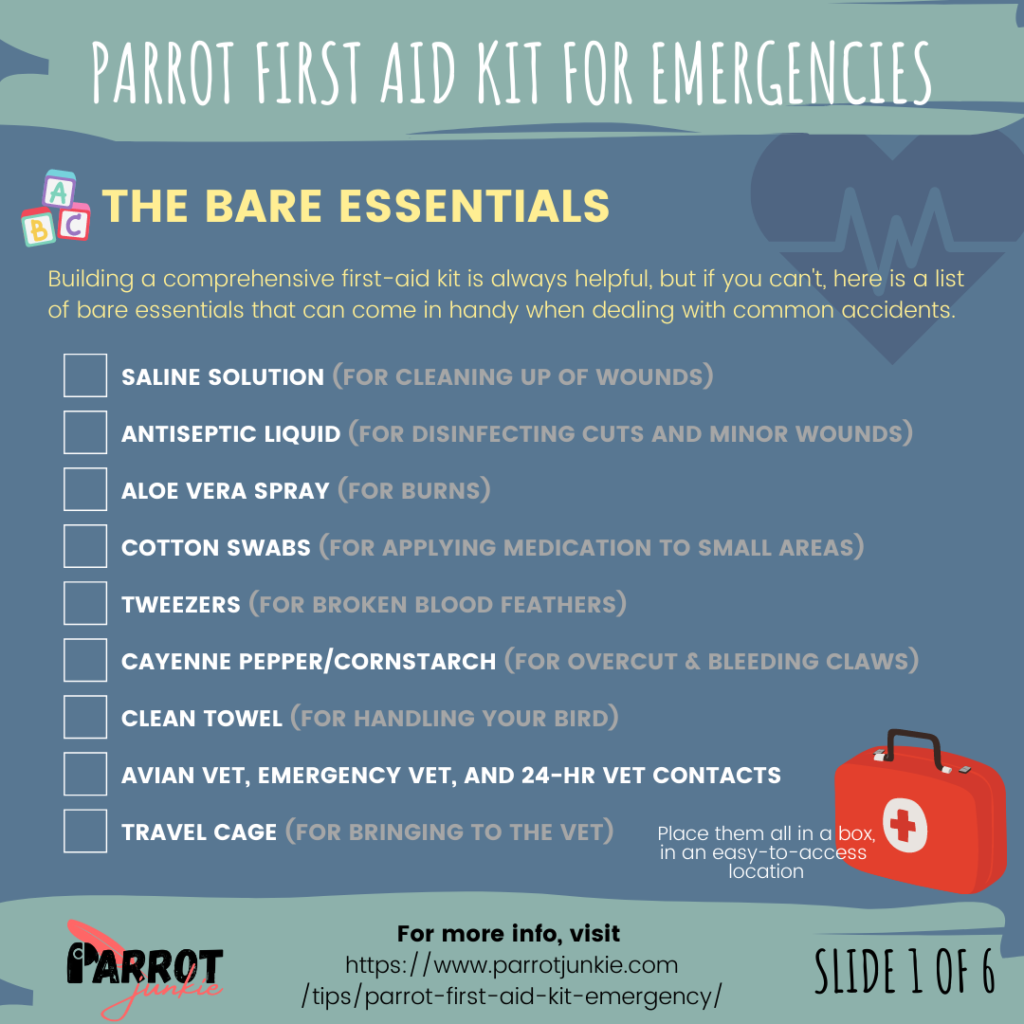
First Aid Box
It goes without saying that you will require a box to assemble your first aid kit. You can store your pet first aid kit in any closed box, but a toolbox would be great because the compartments and storage space it offers make the whole kit more orderly and let you access instruments with ease.
- The first aid box should, as much as possible, contain all the items you will need in a bird emergency.
- Any items used should be placed back into the box after use. You would not want to scramble around looking for items because they are misplaced or stored elsewhere.
- Keep the box in an easily-accessible location in your home or aviary.
Saline Solution
WHAT IS IT: Saline solution is always useful to have regardless whether pets or humans are injured. It often consists of 0.9% dissolved salt (sodium chloride) in distilled water or deionized water.
WHY YOU NEED IT: The purpose of saline solution is to enable proper cleaning of a wound from dried blood and debris, without causing stinging or increasing the risk of infection. For some of us, the initial instinct might be to wash with tap water, however, in some locales, the tap water may have high levels of ions and other water treatment products and bacteria that may not be great to apply on an open wound.
WHERE TO GET IT: You can obtain saline solution from your vet, or from most commercial first aid kits. They are often also offered in the eye care section in pharmacies. While homemade saline can be prepared, it is not often advisable to do so unless you have accurate scales, proper distilled water, and the right type of salt. Even though sodium chloride refers to table salt, proper saline solutions are prepared with medical grade sodium chloride to ensure it is free of bacteria and other residual compounds.
Of course, in an emergency where you have run out of saline solution, you can prepare your own saline solution at home. Just make sure not to store that for a long time just to be on the safe side, as microbes could grow in it.
HOW TO USE IT: Soak a cotton ball or cotton pad with saline solution until it is almost dripping wet, and dab or wipe the injured area of the skin.
Antiseptic Liquid
WHAT IS IT: Commonly-used antiseptic liquid include 1% hydrogen peroxide solution, chlorhexidine, or betadine dilute solutions.
WHY YOU NEED IT: Antiseptic liquids are used to further clean and disinfect skin. Antiseptic liquid can also be used to disinfect your hands and surfaces that your bird comes into contact with while administering first aid.
An important point to note is that these liquids are for superficial cuts and scrapes, and should not be used on open wounds or deep wounds. They should also never be applied on mucous membranes such as eyes, nose, vents, and in the bird’s mouth.
WHERE TO GET IT: These antiseptic solutions can be found over the counter in pharmacies and veterinary clinics. In some cases, they may be sold as a concentrate and needs to be diluted with water to get the right dosage. Pay close attention to this as using the concentrates directly on your bird may cause them harm.
HOW TO USE IT: If it comes in a spray, spray onto a cotton pad and dab or wipe the skin with it. You can also use it to disinfect surfaces and cages that your injured bird will come in contact with.
Regardless what brands may advise, I am not comfortable with the idea of regularly spraying antiseptics and disinfectants at, or in the presence of the birds, as inhalingmicro droplets of such solutions may not be good for your bird’s health in the long term. Some argue that some disinfectants are even used for nebulizing and should be safe, but nebulization is a medical treatment for specific conditions where the benefits outweigh the risks. Think of it this way – we don’t take medicines daily regardless whether we are healthy or not, so why let your birds inhale disinfectants regularly when they are not ill?
AN ADDITIONAL NOTE: There are also some antiseptic ointments and creams available for purchase, but there are some disagreements as to whether they are the best option for birds or not. Ointments and creams are very often made with oils and waxes, and if not properly applied, can result in matted feathers, and subsequently overpreening or even self-mutilation. They are also formulated in a complex formulation with several other ingredients such as emulsifiers and so on, rather than purely hydrogen peroxide or chlorhexidine in water.
Rather than complicating matters, my opinion is that the best bet is to use a water-based antiseptic solution rather than a cream or ointment. Once again, if there is no antiseptic solution available, and you only have antiseptic creams and ointments on hand, it is a decent alternative.
If you have used these antiseptic products on your bird, remember to inform the vet what you have used so that they can pay attention not to mix potentially incompatible products on your bird.
Aloe Vera
WHAT IS IT: Aloe vera is a succulent plant scientifically named as Aloe barbadensis. It has been used for centuries for healing and in skin care products, due to its antioxidant benefits. Its juicy flesh can not only be used as topical treatment, but also eaten to reap its benefits.
WHY YOU NEED IT: Aloe vera is not often mentioned in first aid kits for birds but they have been known all around to be very effective on skin healing, especially for skin burns. They have also been recommended for healing of wounds in wildlife as a natural and soothing option. Aloe sprays are good for soothing cuts, scrapes, minor burns. In some cases, bird feather mutilation issues have also been soothed by the use of aloe sprays.
WHERE TO GET IT: Aloe vera products are generally quite readily available in health stores as well, but the best bet is to obtain an aloe vera spray, rather than the gel. The reason is because gels often contain additional materials to thicken up the aloe juice, which may or may not be safe for your birds.
For those of us who grow aloe vera plants at home, they can also be harvested for their juice to be used for first aid for both humans and our pets. Just be careful to drain away the bitter yellow sap and harvest only the gel part for the juice.
HOW TO USE IT: Spray aloe vera juice directly on the bird’s wound, or spray onto a cotton pad to dab onto the wound. Leave it on the skin – rinsing off is not necessary. It is safe for birds even if they accidentally eat it.
Cotton Swabs
WHAT IS IT: A thin stick with a round cotton tip at each end, commonly used by humans to clean out ears, apply ointment on specific areas of the body, and multiple other purposes.
WHY YOU NEED IT: It is always handy to have a tool like a cotton swab to clean specific areas of skin and feathers, especially in smaller birds. Besides, it is also more sanitary than to use our own fingers to apply medicine onto wounds.
WHERE TO GET IT: They are generally easy to find in any household, lifestyle, medical or health store, and even in supermarkets.
HOW TO USE IT: Holding the stick part, dip the cotton end into solutions or medicines to absorb the liquid, and dab or spread onto the wound area. Do not reuse the cotton swab – throw away after use. Always have a small pack handy in your kit, and store them in a sealed bag or container to prevent dust and dirt from getting onto them.
Tweezers
WHAT IS IT: Tweezers are stainless steel tools used to pick and grip on things, so in the event that your bird has foreign objects lodged within the skin or wound, you can gently but firmly restrain the bird and use tweezers to remove the foreign object. They may come in sharp or blunted ends. To prevent further injury on your bird, try to get those with blunted or flat ends if you can find them.
WHY YOU NEED IT: Regardless of whether you have encountered a broken blood feather, or your bird was pierced by a splint of wood or other objects lodged within their skin, it is very difficult to remove them using your fingers or fingernails. Tweezers would greatly facilitate the removal of these objects swiftly.
WHERE TO GET IT: Tweezers are a common tool in any first aid kit. Alternatively, purchase them from a health store or a DIY store. Some art stores may also sell tweezers.
HOW TO USE IT: Often encountered are broken blood feathers. A blood feather is a new feather that is still growing and has blood vessels within the feather shaft. During the growing phase, the feather is quite sensitive and fragile. If it is broken, the broken shaft can act as a capillary (or a straw) for the blood to flow out non-stop. If the blood flow is profuse, the bird could risk bleeding to death.
If your bird has a broken blood feather and is bleeding a lot, tweezers can be used to pull the feather out, after which pressure can be applied to the area to stop further bleeding. The feather should be pulled out in the same direction of its growth, to avoid further breaking of the feather shaft.
Styptic Powder, Cornstarch, or Cayenne Pepper Powder
WHAT THEY ARE: Styptic powder is often used in veterinary care on various animals including birds, to quickly stop small bleeding wounds by clotting the blood. Styptic powder is made of a variety of ingredients including ferric sulfate, benzocaine, aluminum chloride, and so on. The benefit is that it is very effective and fast-acting, but the cons are that it may burn skin, or your bird might ingest it.
Cornstarch is a natural alternative to styptic powder and works to help blood clotting by absorbing liquids and speeding up coagulation. The benefits are that they are natural and often food-grade, so it does not pose a huge risk if your bird eats it. It is a frequently-used alternative to styptic powder as it is very easily found. The downside is that there is some evidence showing that cornstarch, if applied to wounds already contaminated with bacteria, could increase the growth of bacteria as it is a food source.
Cayenne peppers are chili peppers often used in cooking, belonging to the Capsicum annum species. They contain a compound called capsaicin which is responsible for stimulating the “hot and spicy” sensation we humans experience when eating them. Cayenne peppers also come in a powder form for cooking, and this can be used as a short-term pain reliever as they work to confuse pain transmitters. Birds are much less sensitive to capsaicin, so even if your bird accidentally eats the pepper, they will not feel the burning heat.
WHY YOU NEED THEM: Among the three choices above, chances are you will just need one of them in a “bare essentials” first aid kit. The purpose of these powders is to stop minor bleeding quickly, especially from claws that are cut too short.
WHERE TO GET THEM: Styptic powder can be found in a vet clinic or in online stores specializing in bird-related products. They are sometimes marketed as the brand “Kwik Stop”. Cornstarch and cayenne pepper can be found in supermarkets and grocery stores.
HOW TO USE THEM: They are most often used in cases where your bird has a toenail that has been cut too short, resulting in bleeding. Apply the powder on the nail until the bleeding has stopped. According to certified avian specialist Jeannine Miesle, styptic powder is “OK for beaks and nails, not for anything on the skin” because it can “burn and ulcerate the skin and damage feathers”. However, for minor cuts and bleeding on skin, cornstarch can be used to stop bleeding.
Clean Towel(s)
WHAT IT IS: Clean towels are always useful to have around, and can be used for a few purposes:
- To lay on a flat surface such as a table or in the carrier cage to cushion your bird
- To wrap around your bird for easier handling
- To cover the carrier when transporting your bird around, so that it feels more secure
WHY YOU NEED IT: A minimum of one piece of towel should be available, at least for the purpose of wrapping around your bird for handling. Many birds do not like to be handled or restrained, and may often struggle or bite. Having the towel act as a soft barrier between your bird’s beak and your hands can make it less unpleasant for you so that you can focus on administering first aid.
HOW TO USE IT: Drape the towel gently around the bird’s neck, covering its eyes but not its beak or nostrils, then cradle the bird on your palm, with its back lying on your palm. This video shows the process clearly, first with a toy parrot, then with a real one. In some cases, two people may be required to secure the bird – one to restrain the bird, and the other to administer first aid. It is possible to towel-train your bird, that is, to let your bird be comfortable with being handled in a towel by exposing it to the towel gradually and regularly.
Emergency Contact List
Too many times, I have seen people in bird groups online scrambling for a list of vets nearest to them only when they need it. An emergency list of contacts and helplines is always important to have in an easily accessible location, be it stored on your mobile phone, printed out on a sheet of paper in your first aid kit, or even both.
Consider having these contact details and addresses in your list:
- Your regular avian vet
- A backup avian vet
- A general vet near to you that deals with pet emergencies
- A 24-hour vet or animal hospital/clinic
- Pet poison helpline
- A trusted and reliable person experienced in birds who is willing to help you out in an emergency, especially if two people are needed to treat the bird.
Depending on where you live, not all of the above may be available. If none is available, consider looking online for online vet consultations.
As bird owners, we should always attempt first to contact an avian-specialized vet as this logically gives us a higher chance of getting the right diagnosis and treatment for our bird. Note that an avian-certified or avian-specialized vet is not the same as a “vet who also treats birds”.
That being said, in the event of an emergency, if you are not able to reach an avian vet, having any vet, or even a highly experienced fellow bird owner to help take a look, is always better than nothing. Also, consider that there are also vets that do not specialize in avians but have significant experience in avian treatment, or are generally very skilled at treating any animal.
Take the time to know the vets and resources around you, and make a note of them. In this way, you will not have to be caught in a fix trying to figure out the best course of action when you encounter an emergency.
Travel Cage or Carrier
WHAT IT IS: A small, portable cage that fits your bird while giving it enough space to move around a bit. For small birds, small acrylic fish tanks or medium-sized hamster cages can work, and for larger birds, crates for dogs or cats can be used.
WHY YOU NEED IT: In an emergency, you may need to evacuate with your bird, or quickly bring it to the vet in your vehicle. You will need something that is easy to carry, and provides enough security and comfort for your bird, but not be too big that the bird might climb around a lot and hurt itself, or be too difficult to transport.
WHERE TO FIND IT: Most pet stores selling pet supplies would have selections of cages and crates for pets. Don’t hesitate to look at sections for animals other than birds to find a suitable carrier of the right size for your parrot.
HOW TO USE IT: Line the bottom of the cage with paper towels or a cloth towel. Attach a perch in the carrier for your bird to perch on. Have some bowls ready for some small snacks and water.
The Comprehensive Parrot First Aid Kit
Expanding from the above options for a “bare essentials” first aid kit, following is the comprehensive list of items in a well-equipped parrot first aid kit. Those who do not live near to a vet may want to create a more comprehensive kit so that you will always have the maximum possible resources available on hand to administer first aid to your parrot.
The sections below will be split into:
- Tools and equipment
- Items for cleaning and securing
- Chemicals and solutions
- Transport and evacuation
Tools and Equipment
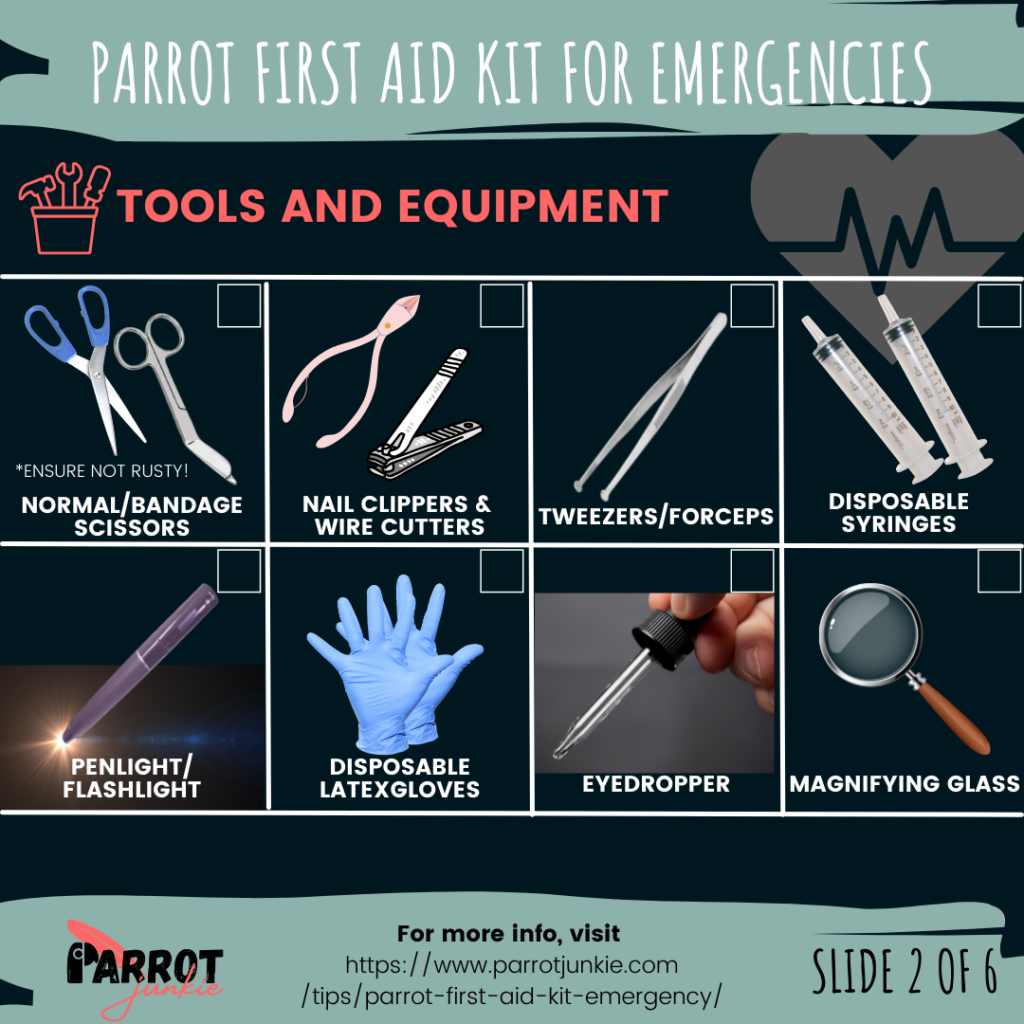
Scissors – Normal or Bandage Scissors
Have both bandage scissors and regular safety scissors available if you can. You’ll need them to construct splints, cut bandages, and cut wrappers. Scissors should be sharp, not rusty, and kept in a secure location inside your first aid bag.
The difference between normal scissors and bandage scissors is that bandage scissors are often angled and blunt, so that it does not scratch the skin when bandages are being cut.
Some first aid kits or health stores would have bandage scissors already available, so these should not be too difficult to find.
Nail Clippers and Wire Cutters
Nail clippers can be useful if you notice your parrot’s nail getting overgrown or too sharp, and getting easily caught in toys or fabric. You can restrain your bird gently and snip off the sharp point, paying attention not to cut too much of the nail such that it leads to bleeding.
Wire cutters would be for cutting off leg bands or leg rings in the event that:
- Your bird has a leg infection and is swelling so much that the leg band or ring is constricting it
- Your bird’s leg band or ring has been caught or tangled in something and needs to be removed before it gets worse
Tweezers or Forceps
When dressing wounds, you’ll need forceps or hemostats to keep tissue, cotton balls, and gauges in place. Hemostats are specialized forceps that can close blood arteries and tissues to stop bleeding. A set of forceps and hemostats, as well as bandage scissors and blades, are included in most first-aid kits and surgical equipment.
For tweezers, read this section here.
Disposable Syringes
Syringes always come in handy to give your pet fluids and medicines, or even to syringe-feed your pet liquid food in the event it is not able to chew on its own. Some syringes come with removable needles – remove the needles as they are not required, and can be a piercing hazard for the bird.
Penlight or Flashlight
A penlight comes in helpful while checking on anything. It can assist you in checking for debris in wounds, bleeding, and damage in your bird’s feathers. Penlights are useful in a variety of situations, so have one in your first aid bag, along with additional batteries. As they are small and compact, with the light focusing on specific areas, they are the ideal choice. However, if you only have a normal flashlight, it is always better than nothing.
Disposable Gloves
Disposable latex gloves are used for handling birds, ensuring that either you or the bird will not contaminate each other. You can have a few pairs in the first aid box available when you need them.
Eyedropper
Eyedroppers are used to administer drugs to your pet’s eyes, as well as to wounds and injuries. If your bird has an eye infection or has gotten something onto its eye, you can flush its eye by generously dripping saline solution on it using a clean eyedropper.
Eyedroppers are generally composed of plastic or glass. Glass eyedroppers are washable and reusable, while plastic ones are usually disposable. Make sure your first aid kit has a few eyedroppers available. Store them in a bag to avoid them collecting dust.
Magnifying glass
A magnifying glass can be used to observe small wounds or identify parasites (such as feather mites) by enlarging the area of observation.
Cleaning and Securing
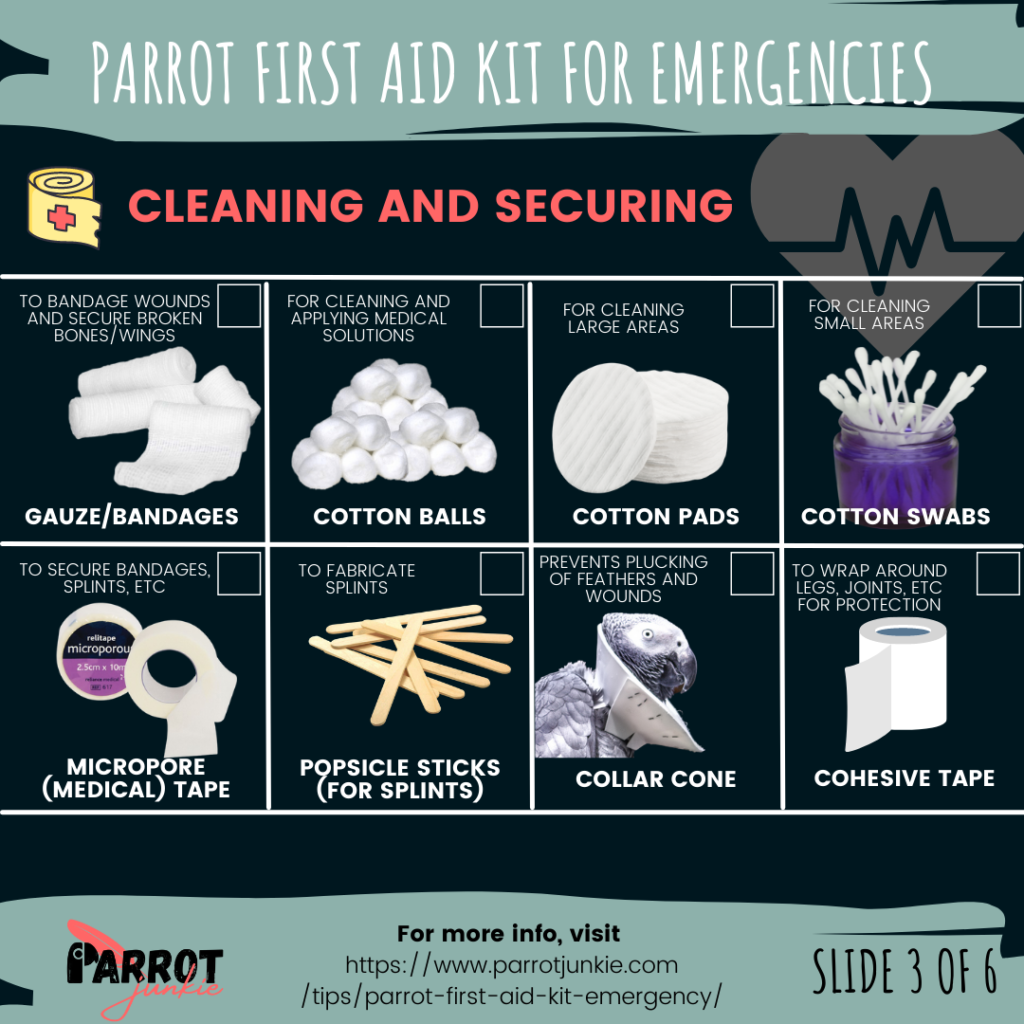
Gauze or Bandages
Gauze rolls and bandages of various diameters are included in every first-aid kit. This is useful for protecting wounds around the claws, legs, and feet, but you may tear or cut them into little pieces to cover cuts and bruises.
Ensure that your parrot does not try to take them away or chew on them! You may consider letting them wear a collar cone to hinder their ability to reach for bandages and wounds.
Cotton Balls
Cotton balls are small balls of cotton that are bunched together. They are very soft and can be used for cleaning, absorbing blood, or for applying medical solutions in specific areas of the bird.
Cotton Pads
Cotton pads are flat pieces of cotton that are useful for cleaning larger areas. For example, you may want to disinfect a section of the table before putting your parrot on it. Cotton pads can be used for such purposes, similar to antiseptic wipes.
While both cotton balls and cotton pads can almost be used interchangeably, I include both here as you’d never know which type you would need during an emergency. It is always to have more options available than less.
Cotton Swabs
Read more about cotton swabs here.
Micropore Tape
Medical tape, also known as Micropore tape, is permeable tape that may be used to bandage wounds. This tape rips easily and adheres effectively to a variety of surfaces, including skin, feathers, and down feathers. Micropore also comes in a variety of widths. They are available at local pharmacies and medical supply stores.
Micropore tape is paper tape that sticks well to the skin, yet is easily removed without leaving any sticky residue on the skin. They are also hypoallergenic, so you do not have to worry about any potential skin irritation with the use of micropore tape.
Popsicle Sticks
Popsicle sticks can be used as splints in the event of a break or an accident. Popsicle sticks may also be used to brace your pet’s wings in the event of an accident that results in fractures or fractured bones. Rebecca Duerr DVM MPVM has created a very comprehensive guide document on how to splint broken bones and wings.
Collar Cone
A collar cone is a device worn around the bird’s neck, which does not restrict movement of the head, yet prevents the bird from reaching out for other parts of its body. It is often used on birds that pluck their feathers due to behavioral or physical issues, but also for birds that are injured. When you have a bandage on a wound or an infected wound that is exposed, you would not want your bird to constantly pick on it, or remove the bandage with its beak.
Creating a collar cone is not difficult, but may be rather specific to the bird. Birds have very thin necks, so you will need to have a good estimate of the collar size so that it will not strangle the bird when worn, but also not too loose that the bird can wriggle out of it.
Here is a useful video showing how to create a collar cone quickly for your bird, created by Love of Pets on Youtube:
Cohesive Tape
Many owners may have a supply of vet tape, which is often used in treating animals. The difference between cohesive tape and vet tape is that cohesive tape has more padding. According to Jeannine, cohesive tape “has more padding” and that vet tape is “all plastic, webbed, solid and hard. It gets very dirty very fast and is sticky.”
Cohesive tape or cohesive bandages can be found in health stores or online, and you may want to consider getting a couple of different widths (narrow and wide) for different purposes and situations.
Chemicals and Solutions

Aloe Vera Spray
Aloe vera spray has been discussed here.
Saline Solution
Saline solution has been discussed here.
Feeding Formula
You may need a small pack of feeding formula in your first aid kit only to keep your ill pet fed. This is different from its usual diet (hard fruits, seeds, nuts, and vegetables). You can get some of these from your veterinarian or a pet store. In cases where your bird is in shock, feeling ill, or having a beak injury, some warm soft food is always welcome. Ill birds may also need more nutrition to help them regain strength as they recover.
Baby bird formula can be prepared by mixing the powder with warm water, stirring well, and then syringed into the side of the bird’s beak slowly. Follow instructions on the packaging of the formula you have purchased to find out the right ratio of water to powder for optimum consistency.
Antiseptic Wipes
Antiseptic wipes are useful to disinfect cages, equipment, surfaces your bird may come into contact with, and your hands prior to handling your bird’s wounds. They can be found in most pharmacies. Wipes with 50 or more counts, as well as diaper wipes, are available in ready-to-travel packets. Use non-scented wipes as perfumes can be harmful to birds. Used antiseptic wipes should never be left lying about, but should be disposed of quickly.
Rehydration solution
Rehydration solution is commonly known as “electrolytes”. I call them rehydration solution here as the word “electrolytes” may cause some confusion and is not very precise. The purpose of these solutions is to quickly hydrate a bird that is ill, refuses to drink, or is in shock. They typically contain certain levels of salts and sugars that are required to balance out the fluid concentration of cells in the bird’s body.
These rehydration products may be sold as powders or crystals rather than in solution form for better storage stability, and you would need to dilute them at the ratio recommended in the product’s usage guide. These products are usually available in pet shops or vet clinics.
Hydrogen Peroxide or Chlorhexidine or Betadine Solution
These disinfectant and antiseptic solutions have been discussed in this section.
Styptic Powder, Cornstarch, or Cayenne Pepper Powder
These are used for clotting blood and have been mentioned here.
Water-based Lubricant
This may seem a little unusual, but water-based lubricants such as KY Jelly have helped some birds suffering from cloacal prolapse, or egg binding.
In cloacal prolapse, part of the cloaca that is supposed to remain inside the body protrudes the body instead, often as a result of straining by the bird, such as from egg-laying. In early stages of prolapse, you can intervene by applying water-based lubricant on the bird’s vent, and using a cotton swab to push the prolapsed tissue back into the vent carefully (without forcing too much).
Egg binding is a dangerous situation where the egg cannot be passed out of the bird, and is stuck either fully inside the hen, or partially outside the hen. This can be rather life-threatening and quick action needs to be taken. Some have had success applying KY Jelly to the vent of the bird to facilitate the egg sliding out.
If you have birds that may have issues like cloacal prolapse, or female birds that have started to lay eggs, you may want to have a water-based lubricant ready to deal with these emergencies. While oil may be the most instinctive material to use, it is actually not recommended as it may turn rancid, or contaminate feathers, making a huge mess.
Transport and Evacuation
Transporting the bird can be as straightforward as going to the vet, but in more critical situations such as disasters, you may need to evacuate together with your bird. In case of an earthquake, a fire, a storm, or a hurricane, you will have to get your parrot and yourself out of the area as quickly as possible. In your evacuation efforts, the goal is to safely take the bird out of harm’s way—without harming the bird itself. The following may come in handy for evacuation:
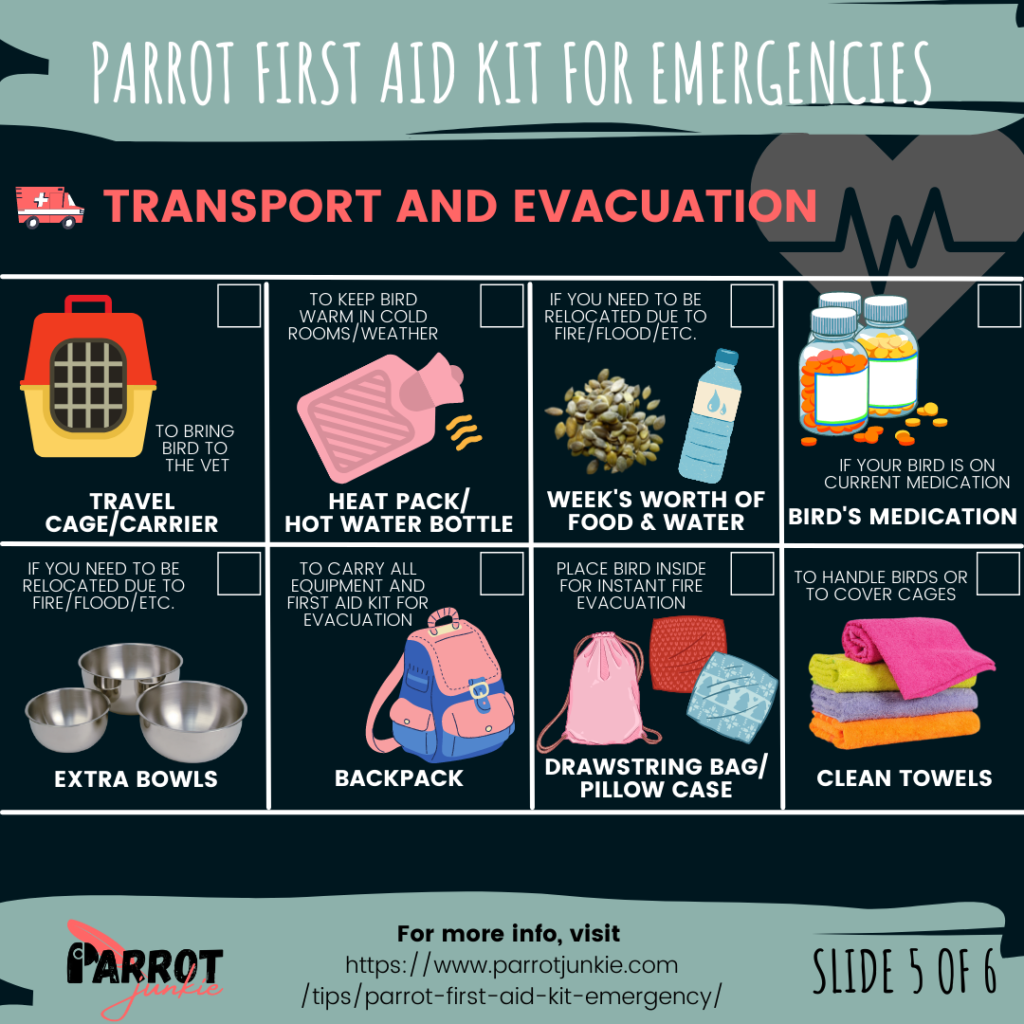
Travel Cage or Carrier
This has been discussed here.
Heat Pack or Hot Water Bottle
Keeping your bird warm when transferring them during an emergency is critical. It is useful to use heat packs or hot water bottles while traveling. These objects can be placed at the bottom of your carrier to warm it up (heat rises). Remember to keep these heat supports away from the bird! You want to get the temperature of the region around the bird up to a comfortable level. We don’t want to add burns to the list of possible injuries.
These heat packs can also be very useful even when your bird is not ill, but you need to evacuate together with them in cold weather due to a fire, flood, or earthquake.
A Week’s Worth of Food and Water
If you’re fleeing a storm, hurricane, tornado, or other natural disasters, you should pack at least a week’s worth of food and water with you. Food must be packed in lightproof and waterproof plastic bags. Water should be kept in a secure drinking bottle. Keep everything in a convenient bag in your pet’s backpack or carrying cage.
Bird’s Medication
Drugs, supplements, or vitamins for your pet — If your pet requires medications, supplements, or vitamins, you must bring them with you. Place drugs in a bag that is simple to carry. If the drug has to be transported chilled, keep ice packs on hand.
Extra Bowls
Two or three extra sets of food and water dishes are recommended. Place this with your pet’s food supply in the backpack or carrier, and remember to wash them with clean water and dish soap after each usage.
Backpack
A backpack would be needed to hold all of the above items. Either store the backpack where your first aid kit is, or you can even store your first aid kit plus all other materials inside your evacuation backpack.
Drawstring Bag or Pillow Case
In the event of disasters like fires, where immediate evacuation is needed, you may not have time to coax your bird out of its cage and into its carrier. I have seen advice to place your bird quickly into a pillowcase, or even a drawstring bag large enough to hold your bird, secure the opening so that your bird will not escape, and evacuate quickly with them.
If you have multiple birds or your birds do not get along with each other, have several pillowcases or drawstring bags available to separate the birds. You would not want your birds to fight within the bag, resulting in more injury, while you are busy trying to get them to a safe place.
Such options with thin fabric material are preferred as they are breathable, and would not suffocate your bird. Also, if your bird is anxious and tries to chew its way out, it takes them a long time to chew a hole large enough in fabric to escape quickly. Do not place your birds in sealed boxes, paper bags, or plastic bags, as these can either suffocate or are easy to chew out of.
Clean Towels
Towels have been elaborated here.
Maintenance and Good Practices
After knowing how to assemble a first aid and evacuation kit for your parrots, it is not the end of the story. You will need to know a couple of maintenance tips and good practices to ensure your kits are in good shape.
[Parrot First Aid Kit Image]
After assembling your first aid kit, pay attention to regularly maintaining it. Save this image for easy referencing!
Always keep your first-aid kit with you in a readily-accessible location. It should be well-stocked with everything you require. Also, if your first aid box contains any pills or treatments, make sure to verify their expiration dates. Medicines and solutions that are going to expire should not be kept. Also, keep in mind that food, eyewashes, and disinfectants have an expiration date, so double-check them.
Final Notes
Are you now prepared to provide your pet parrot with its own first aid kit? Gathering the necessities is a time-consuming task, and there are quite a number of them to be acquired, but the effort would be worth it in case your parrot encounters an emergency.
If the comprehensive list is too much for you, consider at least assembling the bare essentials kit. It is always better to be overprepared than underprepared. Save the checklists to your phone for easy referencing, and always have your vet’s contact details on hand.
If you live in areas that are prone to natural disasters like earthquakes and floods, where evacuation is to be expected, also ensure you have an evacuation plan for you and your parrot.
With these, you’re ready to provide optimum first aid for your parrot. Remember, the tips contained in this article are first aid tips and nothing more. First aid must never replace medical advice from your veterinarian and you should always contact a trusted and qualified vet for any mishaps.
Parrot Junkie www.parrotjunkie.com
Copyright © 2021-2024. All rights reserved.

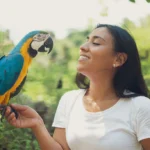

Darryl Aaberg
17 August 2024
I’m so glad you covered this topic.
Linnie Shelling
17 August 2024
This post is a great reference.